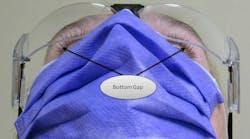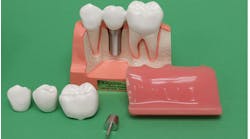A traumatic incident occurred while I was busy in my dental practice on a sunny morning last summer. During a procedure to replace a defective amalgam restoration, a fragment entered my right eye, causing intense pain and shock. Prompt medical attention confirmed the presence of a foreign body. I underwent a healing process with eye drops and an eye patch. Fortunately, there were no lasting ill effects. Approximately a month later, while using a dental drill, some debris entered my eyes, necessitating a thorough flushing.
These two experiences sparked my concerns regarding eye safety in dentistry, despite dental professionals wearing proper personal protective equipment (PPE), such as a dental mask and safety glasses. It brought attention to a potential vulnerability: the “bottom gap.” This gap between protective eyewear and the dental mask or cheek allowed foreign debris to enter my eyes, even though I was wearing safety glasses and a dental mask with side shields (figure 1).
Searching for a better solution
Realizing my OSHA-approved PPE was inadequate, I searched for a better solution. I explored various products like masks with face shields and visors, but they had drawbacks (discomfort, glare, fogging, and distortion) that caused compliance issues. As a faculty member at a dental school, I observed my colleagues and students as an ethnographer. Maanen states, “Field workers may present themselves as delicately lurking, working and getting results, but the results they achieve are always experientially contingent and highly variable by setting and by a person.”1 Through my observations and questioning, I gained a deeper understanding of the bottom-gap problem and was able to synthesize my hypothesis at a greater level.
You may also be interested in ... How fostering a safety culture can save money and stress
The bottom gap
The “bottom gap” associated with traditional dental PPE allowed debris to enter my eyes, prompting me to develop a practical and comfortable solution. Lunch discussions with a former professor sparked my journey as an unintentional entrepreneur. I discovered that unconscious incompetence at the start can be a mixed blessing, but lack of preparation can lead to failure.
The build-measure-learn feedback loop
We identified the problem through a set of napkin drawings and developed a sophisticated method to analyze, validate, and test our hypothesis, entering what’s called the build-measure-learn feedback loop.2 After validating our hypothesis through evidence-based testing, we iterated on a dental mask with a bottom gap deflector shield, marking part one of our innovation pathway. We progressed from the initial napkin drawings to four prototypes—theoretical prototype, virtual prototype, minimum viable prototype, and minimum awesome product3—arriving at the minimum viable rapid prototype (figure 2) as the best solution to get rid of the bottom gaps.
In part one of his book, The Lean Startup: How Today’s Entrepreneurs Use Continuous Innovation to Create Radically Successful Businesses, Eric Ries emphasizes “the importance of learning as a measure of progress for startups.”2 He identifies the value and growth hypotheses as the two most important assumptions giving rise to tuning variables that control a start-up’s growth engine.2
The leap-of-faith phase
As we approached the leap-of-faith phase of our development, we focused on clarifying our assumptions to enter the build phase and create a minimum viable product. Through testing our design prototype, we arrived at a usable, comfortable, and functional product that met the requirements of OSHA, standard 1910.133(a)(1), which mandates appropriate eye and face protection in hazardous environments.4
Our research proved that the combination of masks and protective eyewear has shortcomings, allowing debris to reach the user’s eyes through the bottom gaps. We innovated a solution for health-care providers’ PPE to improve this problem, and we assessed our minimum viable product’s usefulness, comfort, and effectiveness through field testing and evaluation.
You may also be interested in ... Graphic OSHA violations: Don't let this happen to you!
The importance of good feedback
Feedback from dental schools and clinical use revealed an issue with our clear deflector shield; overhead lighting caused reflection and glare, leading to negative user feedback. Although we initially dismissed this feedback as “vanity metrics,”2 we eventually embraced it as a scientific opportunity to improve our product.
By “pain-storming” and conducting a root-cause analysis, we realized that the clarity and geometry of the deflector shield interfered with the user’s line of vision. This realization led to a pivotal moment in our design process, where we decided to switch from a clear to an opaque deflector shield and modify the geometry of the shield. These design changes significantly improved our minimum viable product and even allowed us to print our logo on the deflector shield for brand recognition (figure 3).
Our journey from initial assumptions to product iteration and testing taught us the importance of learning, embracing feedback, and conducting a thorough analysis of customer pain points. Our ability to pivot and modify our obvious solution led to a superior minimum viable product with a unique value proposition in the market.2,5
Recognizing a problem and pivoting instead of persevering, while removing emotional attachment to the product, can save entrepreneurs from the lure of vanity metrics. According to Ries, “Vanity metrics wreak havoc because they prey on a weakness of the human mind.”6
Businesses benefit from customer feedback and should prioritize objective decision-making over personal biases. Our test data indicated that an opaque deflector shield offered a heightened sense of security for wearers due to its opacity.
Vital components of entrepreneurship
Empathy and emotional intelligence are vital in entrepreneurship to help establish meaningful connections with colleagues, coworkers, and customers. Rath states, “You cannot be anything you want to be, but you can be a lot more of who you already are.”7
Prioritizing empathy and emotional intelligence fosters creativity, innovation, and growth. Cultivating empathy throughout an organization is a key to entrepreneurial success. Learning empathy enhances business understanding of comprehensive plans. Emotional intelligence builds trust and followership, benefiting leadership and entrepreneurship.
Business planning extends beyond product validation, with dental schools proving more effective than private dentists for targeting. Higher usage and waste drive sustained sales and volume. This strategy, referred to as the “go-to-market strategy,” involves teaching the art of the new technology to ensure its successful adoption.8
As Steve Jobs famously said, “Apple’s mission was not to give customers what they wanted but to give them what they did not yet know they needed.”9 To meet the standard, we identified industry needs and developed a solution. Objective evidence of persistent problems was crucial. Addressing shortcomings and limitations was a key to market success. Taking on manufacturing, tooling, and funding alone was daunting.
Entrepreneurship is not a solo venture
We formed a well-rounded team composed of CPAs, attorneys, consultants, bankers, insurance agents, bookkeepers, and coaches to handle challenges and set us up for entrepreneurial success. Our efficient team validated and refined our business plan as we advanced through the entrepreneurial stages. The team mitigated liability, ensuring sound practices and meeting risk management principles. We recognized risks such as income loss, investment, personal liability, cash flow challenges, business failure, and health issues. But despite these risks, we understood that entrepreneurship and risk-taking are nearly synonymous and that our success depended on our willingness to put our careers, finances, and mental health on the line.10
We divided shares and brought on two skilled partners to minimize risks and establish a strong foundation. Building a quality team was just the first step; we held structured meetings, delegated tasks, and ensured fair workload distribution to help our team stay motivated and focused. By surrounding ourselves with a capable team, we managed stress and built a more successful business.
The medical device market
As we expanded the team, we opted to outsource production instead of investing in capital for manufacturing. We found a specialized US-based company operating as an original equipment manufacturer (OEM) for surgical face masks. “An original equipment manufacturer traditionally is defined as a company whose goods are used as components in the products of another company, which then sells the finished item to users.”11
The mask manufacturer was FDA-approved, which is necessary for producing medical devices in the US. FDA 510(K) clearance is required to bring the mask to market, and this was achieved through collaboration and a written agreement. During the clearance process, we needed design pivots due to the potential for adhesive and ink to emit toxic fumes. This regulatory pivot forced the company to make further changes. Our team used “pain-storming” to clarify and test hypotheses. As stated by Furr, “The purpose of pain-storming is to gain clarity on what you think the problem is so that you can test your hypotheses.”12
Working through the challenges
The team initially decided to remove the product logo on the deflector shield, opting instead for a plain opaque shield. The next issue became how to attach the deflector shield to the mask without adhesive in a nontoxic manner. After careful consideration, we decided to use an ultrasonic welding process, as described by Beck: “The unusual feature of this bonding process is that no adhesive, no solvents, no heat, no surface treatments, or surface preparations are necessary.”13
The ultrasonic weld attached the deflector shield to the mask, which was FDA-approved for 510(K) clearance. The mask underwent language review, meeting FDA standards as a surgical mask with a bottom gap deflector (figure 4).
After FDA clearance, it was time to showcase our innovative dental mask. We could not articulate it in words, but we knew we had a “minimum awesome product.”3 This intuitive understanding marked a turning point in the design process. Our novel product was praised for its simplicity and elegance. Remaining open to feedback and anticipating end-user needs were vital for product viability.
We observed a shift in our business progression as we recognized the importance of our team members’ strengths in problem identification and validation. Invention and innovation are distinct, with the former being a new creation and the latter improving existing products or processes. Successful entrepreneurship requires identifying markets and unmet needs, as well as distinguishing disruptive and sustaining innovations. Only inventions addressing problems have practicality for entrepreneurship.
Fostering innovation
As we entered a managerial phase, we adjusted communication and approached efficiency and sustainability with an entrepreneurial spirit.14 Unbeknownst to us, we had reached a turning point that resembled the innovator’s dilemma. Our group’s capabilities and resources ultimately determine our limitations. We could not assume that just because we identified a need, developed a product, and entered the market that success would follow. We returned to our roots and recognized that “successful companies want their resources to be focused on activities that address customer needs, promise higher profits, are technologically feasible, and help them compete in significant markets.”15
To maintain viability, it’s crucial to balance sustaining and disruptive innovation. Solely focusing on the current customer base can lead to stagnation. Fueling growth through creative thought processes and disruptive innovation is essential; neglecting it can result in a slow death for businesses. Christensen’s eight principles address the innovator’s dilemma and guide to managing disruptive innovation.15
Innovation, DNA, and corporate culture
Incorporating it into the corporate DNA sustains successful growth and innovative culture. Long-term sustainability requires a balance between innovation and incumbent demands. Understanding traditional and entrepreneurial management benefits both entrepreneurs and managers. Our corporation transitioned from an entrepreneurial to a traditional management approach while comprehensively satisfying our immediate and future customers. We established an “innovator’s DNA” that allows us to pay attention to the present and the future.16
Innovation can be innate or cultivated through corporate culture. Some companies foster out-of-the-box thinking with playrooms and nap spaces, encouraging freedom and interaction. To drive innovation, corporations should promote open thinking, break routines, encourage observation and questioning, and create an innovative environment. Hiring creative individuals and balancing the workforce between doers and thinkers is essential, as is finding a balance between customer needs, growth, and innovation. Corporate DNA, the company’s vision and culture, influences values and behavior. Entrepreneurs must build teams with aligned DNA to achieve their goals. Addressing bureaucracy, providing leadership, and supporting the vision shape a new venture’s DNA for success.
From a napkin idea to a successful business
Transforming a napkin idea into a successful business is challenging. You need a solid business model canvas plan to avoid failure. From my experience as an accidental entrepreneur, common sense and utilization of resources are must-haves to progress from problem to solution to product. A great business model is fundamental for finding favorable solutions and financial sustainability. Establishing customer demand and go-to-market strategies are equally important. Facing challenges, building an effective team, and seeking knowledge will help overcome obstacles along the way. A well-crafted business model directs a venture’s vision, focus, and mission.
Editor's note: This article appeared in the November 2023 print edition of Dental Economics magazine. Dentists in North America are eligible for a complimentary print subscription. Sign up here.
References
- Maanen JV. Tales of the Field: On Writing Ethnography. University of Chicago Press; 2011.
- Ries E. Experiment. In: The Lean Startup: How Today’s Entrepreneurs Use Continuous Innovation to Create Radically Successful Businesses. Currency; 2017:chap 4.
- Furr N, Dyer J. The innovator’s method. In: The Innovator’s Method: Bringing the Lean Start-up into Your Organization. Harvard Business Review Press; 2014:chap 1.
- Occupational safety and health standards. Personal protective equipment. Eye and face protection. U.S. Department of Labor. Occupational Safety and Health Administration. https://www.osha.gov/laws-regs/regulations/standardnumber/1910/1910.133
- Furr N, Dyer J. Master the pivot. In: The Innovator’s Method: Bringing the Lean Start-up into Your Organization. Harvard Business Review Press; 2014:chap 7.
- Ries E. Measure. In: The Lean Startup: How Today’s Entrepreneurs Use Continuous Innovation to Create Radically Successful Businesses. Currency; 2017:chap 7
- Rath T. Conozca Sus Fortalezas 2.0 = Strengthsfinder 2.0. Gallup Press; 2014.
- Furr N, Dyer J. Business model: validate the go-to market strategy. In: The Innovator’s Method: Bringing the Lean Start-up into Your Organization. Harvard Business Review Press; 2014:chap 6.
- Furr N, Dyer J. Solution: prototype the minimum “awesome” product. In: The Innovator’s Method: Bringing the Lean Start-up into Your Organization. Harvard Business Review Press; 2014:chap 5.
- DeMers J. 7 risks every entrepreneur must take. Entrepreneur Media. October 13, 2014. https://www.entrepreneur.com/starting-a-business/7-risks-every-entrepreneur-must-take/238319
- Kagan J. Original equipment manufacturer (OEM). Investopedia. Updated June 15, 2023. https://www.investopedia.com/terms/o/oem.asp
- Furr N, Dyer J. Problem: discover the job-to-be-done. In: The Innovator’s Method: Bringing the Lean Start-up into Your Organization. Harvard Business Review Press; 2014:chap 4.
- Beck RD. Plastic Product Design. 2nd ed. Van Nostrand Reinhold Co.; 1980.
- Drucker PF. Innovation and Entrepreneurship. Butterworth-Heinemann; 1985.
- Christensen CM. The Innovator’s Dilemma: When New Technologies Cause Great Firms to Fail. Harvard Business Review Press; 2016.
- Furr N, Dyer J. Insight: savor surprises. In: The Innovator’s Method: Bringing the Lean Start-up into Your Organization. Harvard Business Review Press; 2014:chap 3.
Peter Arsenault, DMD, MBA, MS, is a 1994 graduate of Tufts University School of Dental Medicine and has master’s degrees in plastics engineering and business administration. He has a fellowship in the American Dental Education Association, is a fellow of the American College of Dentists, and holds several US patents for dental-related products. Dr. Arsenault is currently a professor and the division head of operative dentistry in the Department of Comprehensive Care at Tufts.










